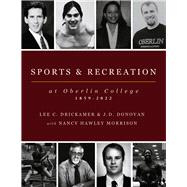The primary rationale for this book is the opportunity to bring together both the rich history of sports at Oberlin College and the related topics involving recreation, the people involved in these endeavors, and the honors and awards that have accrued to many extraordinary athletes, coaches, and administrators. Certainly, it would be possible to conduct numerous Internet searches to examine these topics, but combining modern digital services and the extensive holdings on campus, particularly the Oberlin College Archives and the Department of Athletics and Physical Education, provides a more complete, integrated perspective on athletics and recreation.
The book is unique in terms of the comprehensive coverage of the history of all athletics teams at a single institution. It also includes coverage of most recreational activities, providing a thorough picture of the scope of physical activities on one campus. No volumes with this breadth and depth covering these topics were located for other institutions of higher education during the search for resources used for this book.
The reader will notice recurring themes in the book. First is the enormous growth in terms of the number of varsity sports and many recreational opportunities, particularly for intramurals and club teams. Second is the parallel expansion of the physical structures and playing fields, which were originally found in a variety of locations on and near the campus, but are now gathered together at the north end of campus. Third, separate sections in many chapters celebrate the wonderful accomplishments of Oberlinians in physical endeavors, complementing and augmenting their academic experiences. Fourth, the history of Oberlin athletics involves patterns of ups and downs, both within some sports and across aspects of the entire program. These are examined at appropriate places in the text. Last, there are anecdotes in some chapters which provide insightful information about the roles played by students in the larger context of growth and changes in national sports, as well as offering bits of humor, often a key feature of being part of an intramural, club, or varsity athletics team.
The book is divided into six sections or parts to encompass all aspects of the programs for athletics and recreation. The remaining four chapters of Part I present a starting point with the early history of the program, including three chapters dealing with the locations and venues for athletics. Some of the places used for recreation are covered in later chapters. Part II is devoted to the men's sports teams, arranged in chronological order from the earliest to those added more recently. Part III encompasses women's teams, also in a time-ordered sequence; Title IX resulted in the simultaneous introduction of many women's varsity teams. Part IV is devoted to people, including administrators, the Heisman Club Hall of Fame, the Heisman Club Hall of Honor, and awards made for individual accomplishments by Oberlin athletes and teams. Selected recognition received for all-star status at the conference, regional, and national levels are presented with each team. Part V presents the range of activities encompassing intramurals, club sports, dance, and other recreational pursuits. Part VI covers the move, during the past several decades, toward physical fitness and provides concluding thoughts and visions for the future of Oberlin's sports and recreation programs.






